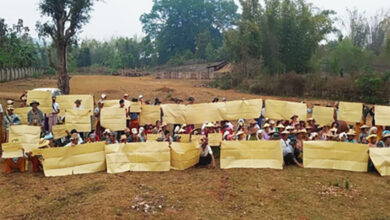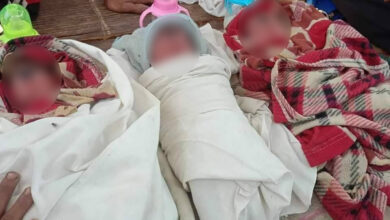Dengue Fever – Children at Risk

Poe Cho lies small on the floor of the children’s ward at Mae Tao Clinic. His tiny body has been stilled by dengue fever. Poe Cho, 7, was infected by dengue when bitten by the Aedes mosquito while staying at the Yaw Bu Temple in Myawaddy.
For three days, Poe Cho, fought against the headaches, fever, aching joints and general body pain that earned dengue its notorious nickname – ‘bone-breaker’.
Finally, worry over Poe Cho’s sickness forced his mother, Naw Khee, to gather up her three children and the boy’s grandmother and cross over to the Thai border town of Mae Sot. Naw Khee spoke to Karen News.
“We went to [Mae Tao] the Clinic for help. I was worried. Normally he’s a noisy boy, talking and playing all the time. It’s strange to see him like this.”
Naw Khee dabs a wet towel on Poe Cho’s hot forehead in an attempt to comfort him.
According to a fact sheet on the World Health Organisation’s (WHO) website, Naw Khee has every right to be concerned about her son.
The World Health Organization classifies dengue as “the fastest growing mosquito-borne disease, with almost half the world’s population now at risk” and “one of the leading causes of serious illness and death among children.”
Nan Mae Soe has worked as head of Mae Tao Clinic’s Child Health Department for more than 10 years and now works as a medical manager at the busy clinic. Nan Mae Soe explained to Karen News that dengue can be agonizing illness and especially so for the young.
“It’s painful. Headaches are severe, joints hurt and the fever is high.”
Nan Mae Soe points out to Karen News that dengue affects not only the sick, but the whole family.
“The parents can’t work, they need to look after the patient. These people have come here for their child. They will probably stay a week. The health care is free, but it’s expensive for them to take time off work.”
The WHO estimates that “up to 50 million [dengue] infections occur annually with 500 000 cases of dengue haemorrhagic fever and 22,000 deaths mainly among children.”
The WHO describes dengue as “a mosquito-borne viral infection causing a severe flu-like illness and, sometimes causing a potentially lethal complication called severe dengue.”
Every ‘rainy’ season thousands of people in Mae Sot are infected with dengue fever. Nan Moe Soe said that the high-risk months are June, July and August. An academic article in The Journal noted that, “Mae Sot district is a dengue endemic area in which outbreaks occurs periodically every 2- 3 years. During 2003, the Dengue Hemorrhagic Fever (DHF) morbidity rate in the district was the highest in Tak Province.”
The Thai Public Health Ministry, estimated that between 100,000 and 120,000 people contracted the disease in 2013. In 2012, there were 74,250 cases and 79, recorded fatalities in Thailand.
Sitting across from the motionless Poe Cho, in Mae Tao Clinic’s Child In-Patient Department, is Maung San Win, also seven and a novice monk. His family live in Mae Sot and like Poe Cho’s family his mother brought the family with her to Mae Tao Clinic.
“He’s has dengue, we didn’t know. Maung San Win was crying a lot with headaches, pain and fever. He couldn’t eat. Now I’m worried his baby sister has dengue also.”
Nan Mae Soe explains that for dengue there is not yet a vaccine for dengue.
“There’s no treatment, all we can do is keep them under observation, reduce the fever, make sure they are comfortable and do not dehydrate.”
The World Health Organisation website confirms Nan Mae Soe observations that there is “no vaccine or any specific medicine to treat dengue. People who have dengue fever should rest, drink plenty of fluids and reduce the fever using paracetamol or see a doctor.”
The WHO website warns that “severe dengue (also known as dengue hemorrhagic fever) is characterized by fever, abdominal pain, persistent vomiting, bleeding and breathing difficulty and is a potentially lethal complication, affecting mainly children.”
The WHO urges people who suspect they may have severe dengue to get early medical help as “clinical diagnosis and careful clinical management by trained physicians and nurses increase survival of patients.”
Nan Mae Soe explained that the best way to combat dengue is prevention.
“People need to clean out places that mosquito lays eggs. Containers used to store water should be properly covered, water containers should be emptied, scrubbed clean at least once a week. Gardens should be kept clear of places that mosquito can lay eggs – old cans, plates and containers should be overturned.”




